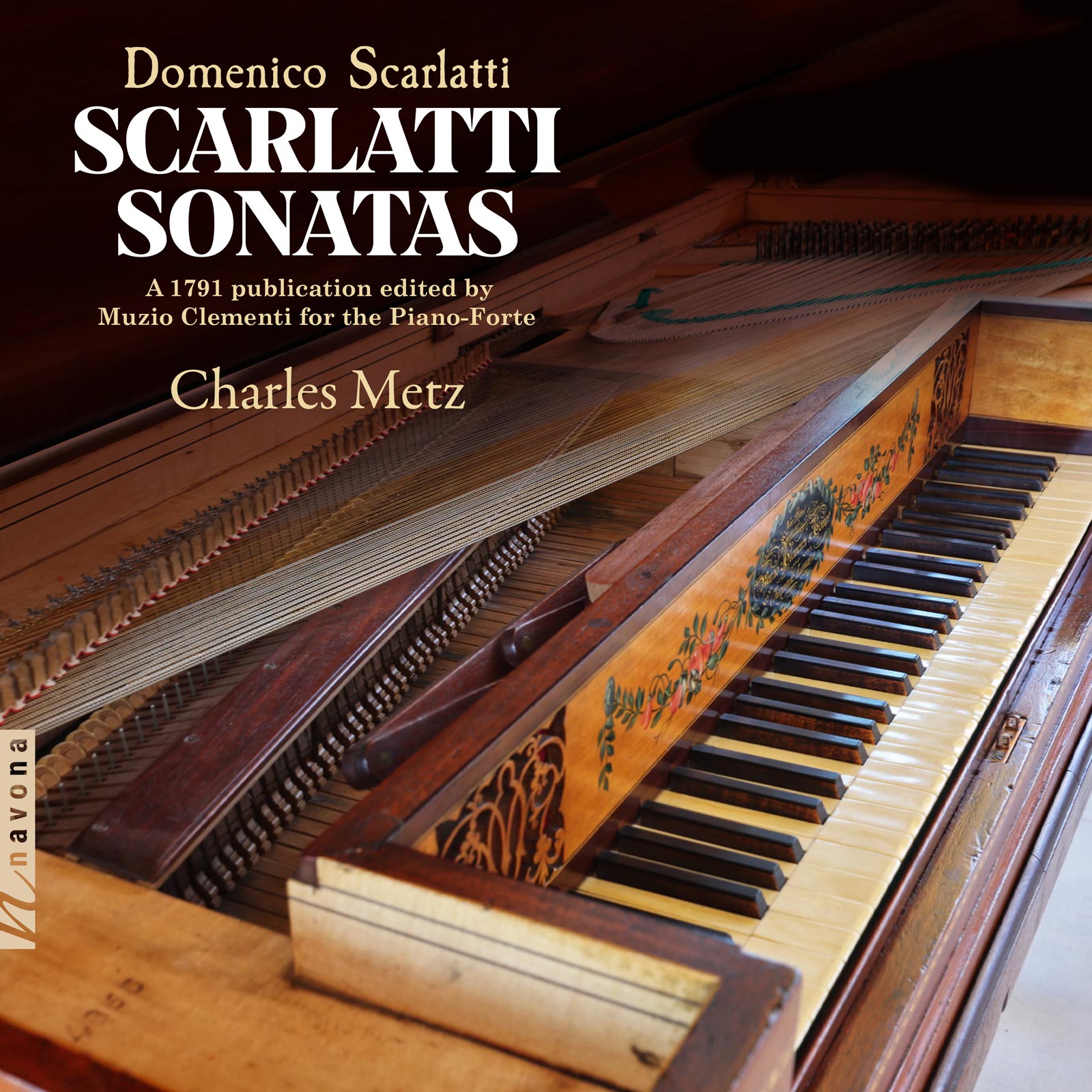Scarlatti Sonatas
Domenico Scarlatti composer
Charles Metz piano
Ivory keys worn by two centuries of passionate musicians tell a story of musical evolution on SCARLATTI SONATAS, an album of solo harpsichord sonatas by Domenico Scarlatti, Antonio Soler, and an unidentified composer. Performed today by pianist Charles Metz, these works were first adapted for performance on the pianoforte in 1791 by Muzio Clementi, who breathed new life into Scarlatti’s timeless work with marked dynamics, articulations, and more. While Metz’s choice of repertoire holds ample historical significance, so does the instrument he employs to perform them — an 1806 square piano built by Clementi himself.
Listen
Stream/Buy
Choose your platform

Experience in Immersive Audio
This album is available in spatial audio on compatible devices.
Stream now on Apple Music, Tidal, and Amazon Music.
Track Listing & Credits
| # | Title | Composer | Performer | |
|---|---|---|---|---|
| 01 | Sonata I, K. 378, Allegro assai, F major | Domenico Scarlatti | Charles Metz, piano | 4:06 |
| 02 | Sonata II, Andante Cantabile, F major | Anonymous, attrib. Samuel Wesley | Charles Metz, piano | 5:12 |
| 03 | Sonata III, K. 380, Allegro commodo, F major | Domenico Scarlatti | Charles Metz, piano | 6:19 |
| 04 | Sonata IV, K. 490, Cantabile, D major | Domenico Scarlatti | Charles Metz, piano | 9:35 |
| 05 | Sonata V, K. 400, Allegro molto, D major | Domenico Scarlatti | Charles Metz, piano | 3:32 |
| 06 | Sonata VI, K. 475, Allegro di molto, E flat major | Domenico Scarlatti | Charles Metz, piano | 5:17 |
| 07 | Sonata VII, K. 381, Allegro, E flat major | Domenico Scarlatti | Charles Metz, piano | 5:08 |
| 08 | Sonata VIII, K. 206, Un Poco Andante, E major | Domenico Scarlatti | Charles Metz, piano | 11:26 |
| 09 | Sonata IX, K. 531, Allegrissimo, E major | Domenico Scarlatti | Charles Metz, piano | 4:04 |
| 10 | Sonata X, K. 462, Andante, F minor | Domenico Scarlatti | Charles Metz, piano | 7:28 |
| 11 | Sonata XI, K. 463, Allegro molto, F minor | Domenico Scarlatti | Charles Metz, piano | 3:21 |
| 12 | Sonata XII, No. 29, Allegro, F major | Antonio Soler | Charles Metz, piano | 5:42 |
Recorded March 27-29, 2023 at Skywalker Studios, located at George Lucas’s Skywalker Ranch in Lucas Valley, near Nicosia CA
Recording Production, Editing & Mastering David V. R. Bowles
Recording Engineer Dann Michael Thompson, Skywalker Sound – Scoring Stage
Instrument Tuner & Regulation Dale Munschy
Photos by Cory Magno and Aaron Jay Young
Executive Producer Bob Lord
A&R Director Brandon MacNeil
A&R Chris Robinson
VP of Production Jan Košulič
Audio Director Lucas Paquette
VP, Design & Marketing Brett Picknell
Art Director Ryan Harrison
Design Edward A. Fleming
Publicity Aidan Curran
Artist Information

Charles Metz
Charles Metz graduated from Penn State University with a B.F.A. in piano. Following graduation, he began private harpsichord lessons under the legendary Igor Kipnis. He continued his harpsichord studies with Trevor Pinnock while earning a Ph.D. in Historical Performance Practice at Washington University in St. Louis. More recently, Metz has worked with Webb Wiggins and Lisa Crawford at the Oberlin Conservatory. He has performed solo recitals at the Smithsonian Institution in Washington DC, Oberlin Conservatory, University of Michigan, and Penn State University in State College PA. He has appeared with the St. Louis Symphony Orchestra, Kansas City Baroque, and the Newberry Consort of Chicago.
Notes
Its voice hadn’t been heard in decades. Its original ivory keys were worn down after two centuries of ardent keyboardists pouring their musical souls into the instrument. It was a square piano, built in the first years of the 19th century by the leading pianoforte builder and preeminent composer, Muzio Clementi. It bears the stamp of serial number 4863. According to a list compiled by Leif Sahlquist appearing in the Friends of Square Pianos, the instrument was built in 1806 in Cheapside, London. It was a modest square piano, small enough to fit in the most modest of middle-class English homes. Its first sounds likely came from a progression of young women cast straight from a production of Pride and Prejudice. Jane Austen girls of modest musical ambition, who could polish another “refinement” seen as necessary to enhance their marital prospects. But now, 200 years later, the instrument was found sitting in an antique shop in Santa Barbara. How the instrument found its way to the California coast is unknown and the ghosts of the centuries of players can only be imagined. But after some loving and meticulous restoration by Dale Munschy of South Weymouth MA, the instrument has her voice back and is singing once again.
Square piano-fortes were at the forefront of the piano-mania which would consume Europe throughout the 19th century. Like Henry Ford’s Model T, the square piano’s modest cost brought keyboard music making within the grasp of a wide population. And the sensation took off. Technological and engineering advances meant the evolution of the modern piano would now accelerate at exponential speed. Escapement actions, wrapped wires, cross stringing, each season brought new advancements, leaving the piano the iPhone of its era: a personal device of immense popularity that served to connect people, families and cultures. At approximately one third the cost of a grand, the square piano-forte became a phenomenon in Europe and especially London. During the first decade of the 19th century Clementi and Company was manufacturing, on average, three instruments every day. All with skilled craftsmen using hand tools, importing woods and ivory from around the world. Broadwood and Sons produced even more instruments during this period.
The expressive capabilities of these instruments soon eclipsed the revered harpsichord which went out of favor in the 1780’s. The last known harpsichord built by Broadwood and Sons was in 1793.
Muzio Clementi, being a skilled performer, composer, renowned teacher, astute businessman and publisher, was in an ideal position to take advantage of this radical change of instruments in the music world. Buying the bankrupt firm of Longman & Broderip, Clementi was building instruments by 1798. As a performer he could guide the development of his instruments in touch and sound quality. He traveled Europe, performing on his instruments, taking some of his students such as John Field to also play and promote the instruments to the public. Sales soared and his piano-fortes became recognized as some of the best instruments of the day. Clementi became an extraordinarily rich man, dying in 1832 as the second most wealthy musician of the 19th century following Gioachino Rossini.
Domenico Scarlatti published his Essercizi in London in 1738. They were very popular, there were numerous publications of Scarlatti sonatas which appeared before 1800. Clementi, using his own elegant collection of manuscripts, took advantage of the popularity of the Scarlatti sonatas by publishing 12 sonatas in 1791 edited for the piano-forte or harpsichord. Including the harpsichord was more for sales of the edition to those who still owned a harpsichord and had not made the transition to piano-fortes as Clementi carefully marks dynamics and articulations in the score which became the first edition to do so for Scarlatti. There is an increased marking for legato which was a change from the articulated style of the harpsichord. Several of the sonatas in this edition were appearing for the first time in England. Another unique feature of this publication is that Clementi transposed two sonatas so that the 12 sonatas had a defined harmonic progression, going from F major down a minor third to D major then up by half steps back to F major making the set of 12 a “complete work.”
Two of the sonatas are not actually by Scarlatti. Whether or not Clementi knew this is unknown. The second sonata is unidentified, and the last sonata is by Antonio Soler.
The instrument that Clementi was most likely playing in 1791 was a Broadwood. This recording is on an instrument which is 15 years after the publication and an instrument slightly more developed which is capable of bringing out more nuances Clementi indicates in the score. Several more printings of this edition of 1791 happened in France in 1793 and again in London ca. 1810. No question this edition was sitting in many a London home in 1806. Carl Czerny published an edition of Scarlatti sonatas in 1839 which includes all 12 of the sonatas of this edition, complete with the Clementi transpositions and not identifying the sonatas misattributed to Scarlatti. It is obvious this 1791 edition was a basis for more publications in the 19th century. It was an important work.
I am indebted to Laura Cuervo whose article “Shedding light on late eighteenth-century British piano performance style through Clementi’s edition of Scarlatti’s Chefs-d’oeuvre, for the Harpsichord or Piano-Forte,” in the Muzio Clementi and British Musical Culture publication gave me much detailed information about this 1791 edition.
— Charles Metz

